 We’ve talked about the tech in detail and even speculated about what KTM’s fuel injected two-stroke would really be like. Now we have ridden both the 250 XC-W and the non-US model 300 EXC and we can say for sure what they are like. The short of it is that 80% of riders will not notice any performance difference between a carbureted two-stroke XC-W–if they were not told the bike was fuel injected, they would never know. It is that similar so some might speculate that there is no reason for a FI two-stroke. But there is so much more to this story.
We’ve talked about the tech in detail and even speculated about what KTM’s fuel injected two-stroke would really be like. Now we have ridden both the 250 XC-W and the non-US model 300 EXC and we can say for sure what they are like. The short of it is that 80% of riders will not notice any performance difference between a carbureted two-stroke XC-W–if they were not told the bike was fuel injected, they would never know. It is that similar so some might speculate that there is no reason for a FI two-stroke. But there is so much more to this story.
Riding KTM’s TPI (Twin Port Injection) is like riding a perfectly jetted bike that runs on the lean side to an experienced rider. The first sensations are that there is little if any difference, especially in the 250cc bike when compared to carbureted. The throttle response is precise, sharp and overall very smooth producing a flat torque curve just like the carbureted 2017 when it is jetted spot-on. But if you are looking for what the FI does and you start exploring and looking for the differences, you can find them.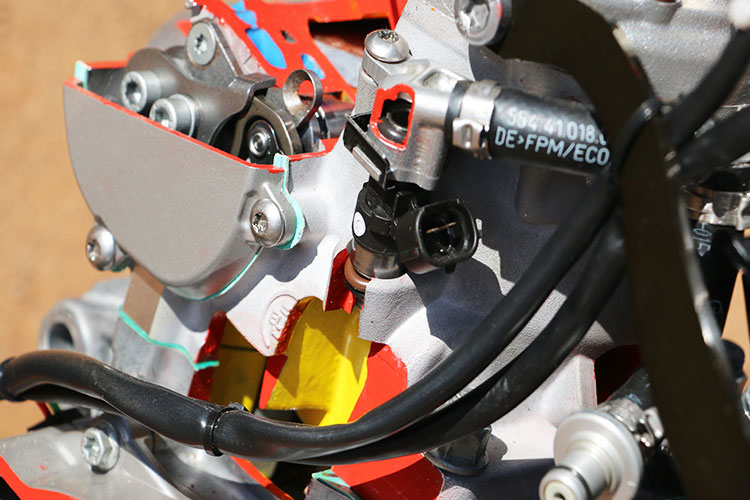
The first thing is, just like a four-stroke, the throttle can be opened up quite a bit more at low-low RPM and the engine will continue to run and not bog. The throttle can be opened fast or slow and will not bog. When doing this and doing it in an RPM range that might get a carb confused and produce a “hit” of power, this KTM FI will not get upset and always pulls smoothly and consistently. For most riders the throttle response, though sharp and positive, produces less hit when compared to a carbureted bike with a similar amount of turning of the throttle. In talking with the engine management R&D guys, this was by design and purposeful so that the bike is easier to ride and control in tough conditions. Maybe that is why KTM chose Erzberg to introduce the bike and was not shy about allowing journalists to tackle some of the toughest sections if they felt the need. We did.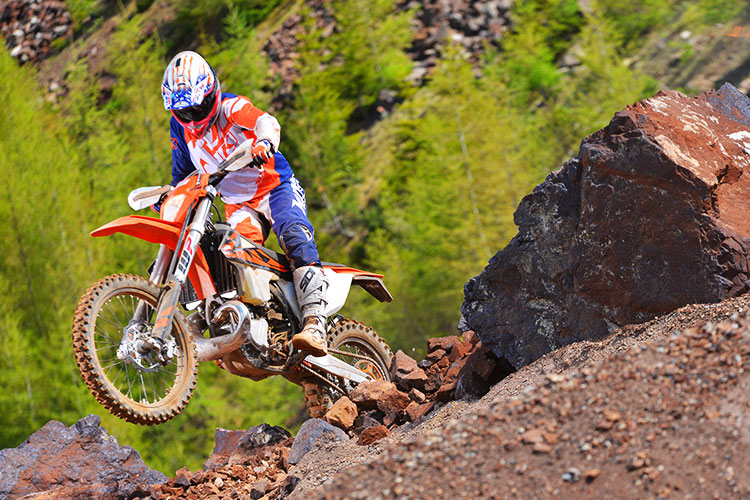
For the most part there is really no significant difference in power output anywhere in the spread compared to current 2017 machines. Like we said the overall “jetting” has a leaner feel than what most riders would feel comfortable running a carb in both fuel to air and also oil to gas. Significant testing on KTM’s part has shown this is a safe setting even with oil to gas ratios that run in the range of 70-100:1 depending on the throttle position and RPM. And due to the nature of FI and its ability to allow the engine to spin to ridiculous RPM without falling off like a carbureted motor, KTM had to place a rev limiter inside the ignition so riders didn’t blow the bike up with excessive RPM. So often times on a wide-open upshift you can hear a loud pop from the exhaust that some assumed was due to a lean condition which isn’t the case.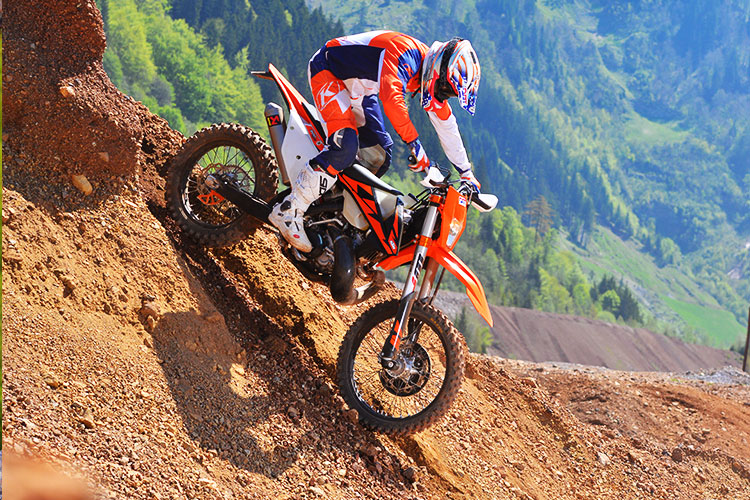
As you learn to trust the FI the same as–then more than a carburetor, you can also learn to twist the throttle farther and faster to get back any snap you might feel you are missing. You can also let the engine lug down significantly farther, especially under larger loads without needing to cover the clutch. When on the clutch and crawling over rocks or climbing when traction is lacking and spinning is unwanted, getting the power reduced is easier as the motor seems to want to continue to run more than it wants to stall. On both of the engine sizes this is the case. There was also the accessory ignition map switch fitted on many of the bikes we rode. It is more noticeable than before as now it changes both ignition and fuel mapping with the second map being a less aggressive setting. It tames the hit or pick up even more and especially if the rider is a little crazy with the throttle there is much less hit.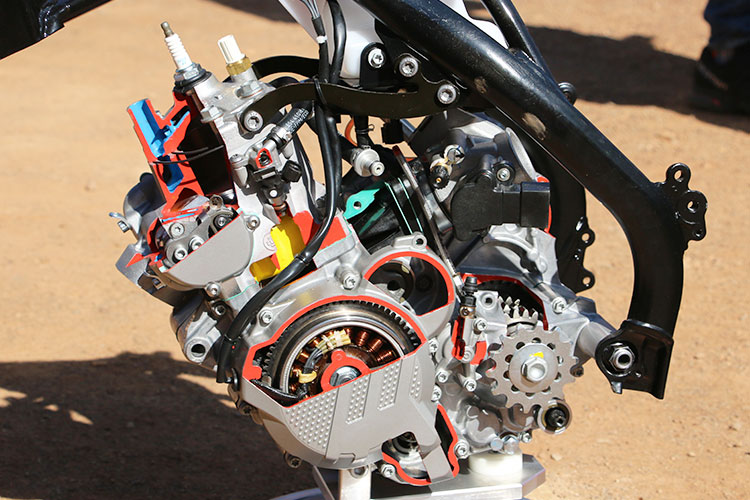
So while there isn’t a significant power change between the bikes there are characteristics of the 250 and 300 that stand out. The 250, like always, feels a lot more peppy on the smaller throttle positions and in comparison more responsive and quicker revving than the 300. It feels faster even if it isn’t unless a rider really uses that peppiness to get into the upper RPMs and continues to ride the bike there. Here the 250 stays light and nimble but makes plenty of power for all but the steepest of power robbing hill climbs.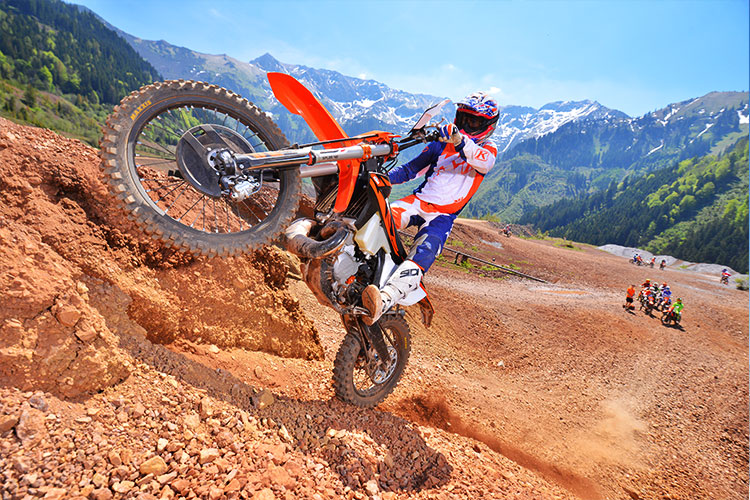
The 300cc engine has a richer setting feeling and tamer level of throttle response in the first 1/8-throttle, while at the same time producing a noticeably larger amount of torque above what most would expect the additional 50cc to do. That torque, when put to use, allows the bike to easily pull a taller gear. In very technical conditions like in the rocks or on hills with little run-up, the 300 can bog through the tough stuff keeping traction then continue to pull or even rev up and scream depending on how a rider operated the throttle when the higher power is needed. At any place in the powerband the 300 does not feel as responsive as the 250. The less aggressive position of the map switch makes a more noticeable change in the power delivery as well. Most novice riders found the second map position a benefit on the 300 on the rocky forest trails of Erzberg. 
So when it comes to the story of TPI two-stroke it is that KTM has integrated the systems without losing any performance and in some very critical areas gaining advantages. It is more efficient in fuel and oil consumption above just the spilling out of a carburetor overflow lines or a riders excessive oil/gas ratio. We feel the system is in its infancy and really has some serious potential to allow tuning and customization with some of the FI management systems that are and in use with four-strokes like Yamaha’s Power Tuner or a similar device a little later out. We know in the short term KTM will produce additional mapping and ignition settings a dealer will be able to program into the ECU for different levels of riders or different types of conditions. The need to meet EURO 4 and farther out homologation standards hastened the need for KTM to finish the TPI system for 2018. KTM producing and releasing these bikes will give the whole industry a kickstart in where FI can take two-strokes. With time we will see the increased performance a digital system can have over the needles, jets and messy simplicity of the familiar carburetor. Right now after riding the bikes there isn’t much increase but we are sure it will come fast, just like it did with the four-stroke.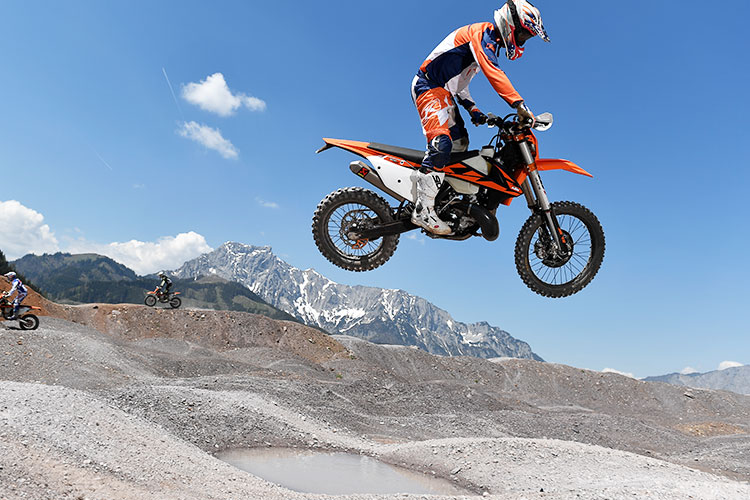
We saw nearly 40 journalists, factory riders and Erzberg Rodeo guides from all over the world and of all ability levels flog the bikes for a full day of riding. Aside from flat tires and the more common crash, we did not see any hiccups or any sort of failure. Most riders seemed to be very pleased overall. Riders with a motocross background for sure were wanting and expecting more snap or hit. We will have to see if this is easily tuned into the system like it can be with four-strokes for the right applications or if FI has some limitations here? Other riders, by either feel or due to the exhaust notes of the bikes, (especially the high RPM pop) were feeling the setting was lean, but nothing in use really showed any downside because of this. The upside, fuel consumption is claimed to be 20-30% improved and we believe that. 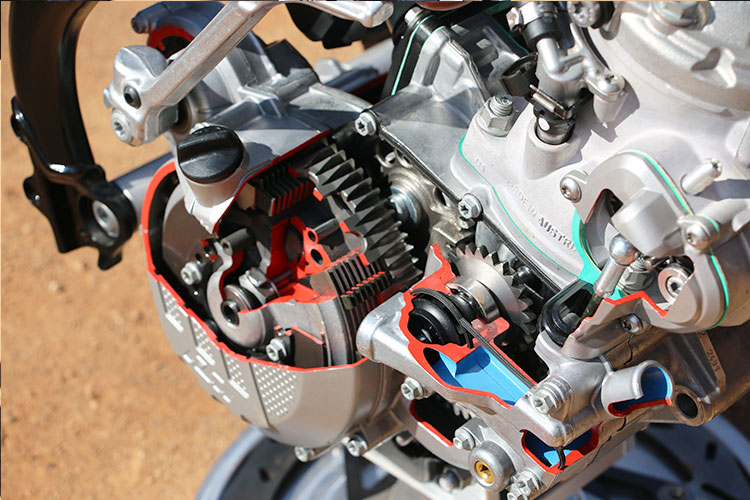
Onto the rest of the bike. Most of the time we were riding the non-US spec model which means it has Maxxix tires (or Metzeler on the Six Days model) and different stickers. KTM had also littered the fleet with different Power Parts like mufflers, triple clamps, levers and a significant amount of bling items depending on which bike you were on. But for the most part the 250 EXCs were otherwise similar to the bike we will see in the US come October. 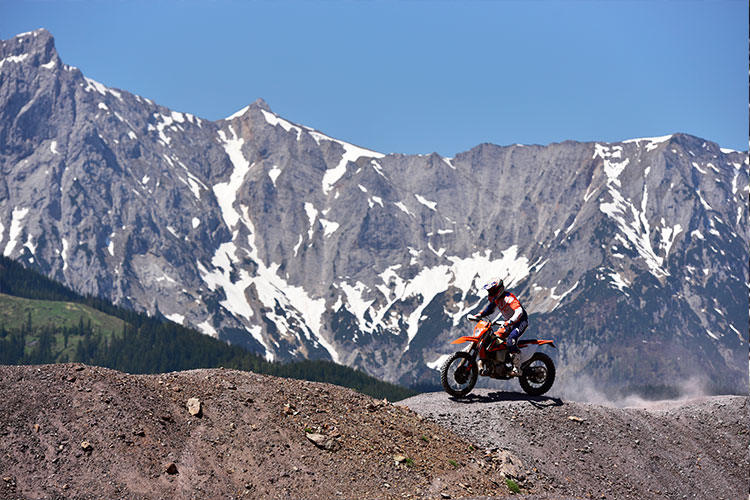
Everything we said about the 2017 KTM 300 XC-W in handling and suspension remain true for the 2018 bike. It is basically an identical package that will gain a small amount of weight from the larger ignition system and from the small amount of weight the oil injection system and fuel pump will add. But since the fuel capacity will drop just a little (the tank is slightly smaller to allow room for the oil tank inlet) things will all balance out and we did not notice any weight gain feeling. If anything the bikes felt just a touch lighter because of the crisp mature of the power. 
WP have continued the development of the Explor fork and PDS suspension. Now the outer tubes of the forks have a new taper to better match the flex character of the inner tubes for less binding. We could not tell outright on the two-stroke but we have noticed this change on a 450 XC-F we have been testing back in the US– we feel it is an overall improvement, small but significant. There have been slight adjustments in internal valving on both ends and we are still pretty impressed with the way the suspension works and how it works well for such a wide range of riders. With just minor clicking on the fork or the shock most were perfectly pleased at Erzberg. We rode in a bit of every condition an XC-W-type bike might be used, including some very jumpy bumps and bottoming hits in drop-offs, at the bottoms of hills and it performed excellent. One standout Power Part was the adjustable preload top cap to the fork (standard on the Six Days bike) where you can click in 3mm increments of fork preload very easily. It works and with such precise handling chassis it makes tuning the ride very quick and easy.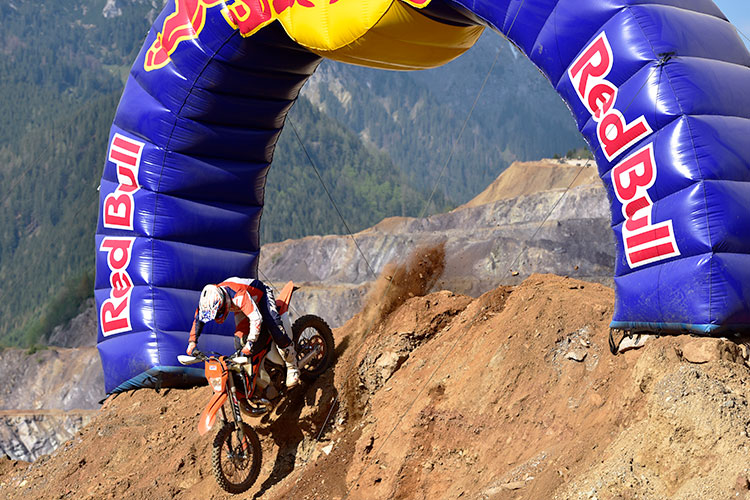
Hopefully we’ll be able to get a test bike back in the US when they arrive to see how it works in our more familiar testing grounds and conditions, but we are told that these bikes are basically sold out and in high demand. That isn’t surprising as a lot of riders have a desire for the newest equipment. KTM’s track record of bringing new stuff that is “Ready To Race” has been very good and we don’t see any difference here.
Shortly we will have an additional story on the history and background of KTM’s FI development.
Here is a good impression from Dirt Rider with some additional information:
http://www.dirtrider.com/2018-ktm-250-xc-w-tpi-review
Support DBT by shopping through the links below:



5 Responses to “2018 KTM 250/300 EXC/XC-W TPI Riding Impression”
ETicket55 .
Excellent! This is probably going to drag me back to riding a smoke … er …’non-smoker’ again!
Thanks for the detailed report, guys … mucho appreciado!
ETicket55 .
One hopes that somewhere in KTM’s ‘skunk-works’ … is someone working on a mid-size, big-bore, fuel-injected, 2T adventure bike. Wouldn’t that be a hoot. :^)
ClanLoner
The upside, fuel consumption is claimed to be 20-30% improved and we believe that.
Ok you have my attention…
arthur pappas
Thanks for the review, Jimmy! I expect Beta and Sherco to unveil FI enduro’s with their next-year models. Don’t know about Gas Gas due to their restructuring, but no doubt they have FI in the works, too.
This gets me thinking about the YZ250X. Will Yamaha throw its hat into this arena and go “all in” like the Europeans, or do they stand pat and ride this aging but still competitive platform into the sunset? If Yamaha leaves this bike unchanged for another couple years, they could feasibly price it three grand cheaper than the Euro bikes.
Interesting times.
KiwiBri
A FI version of the YZ250? Starting to think that maybe the elusive “unicorn”.. nothing on horizon for the 2019 models.. who knows, perhaps 2020 ?